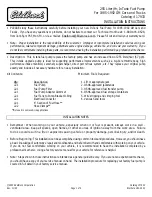
System limits
Sudden tire damage
Sudden serious tire damage caused by
external circumstances cannot be recognized
in advance.◀
A natural, even tire inflation pressure loss in all
four tires will not be recognized. Therefore,
check the tire inflation pressure regularly.
The system could be delayed or malfunction in
the following situations:
▷
When the system has not been initialized.
▷
When driving on a snowy or slippery road
surface.
▷
Sporty driving style: spinning traction
wheels, high lateral acceleration (drifting).
▷
When driving with snow chains.
Actions in the event of a flat tire
Normal tires
1.
Identify the damaged tire.
Do this by checking the air pressure in all
four tires.
The tire pressure gage of the Mobility Sys‐
tem, refer to page
, can possibly be
used for this purpose.
If the tire inflation pressure in all four tires
is correct, the Flat Tire Monitor may not
have been initialized. In this case, initialize
the system.
If an identification is not possible, please
contact the service center.
2.
Fix the flat tire where applicable using the
Mobility System, refer to page
Run-flat tires
Maximum speed
You may continue driving with a damaged tire
at speeds up to 50 mph/80 km/h.
Continued driving with a flat tire
If continuing to drive with a damaged tire:
1.
Avoid sudden braking and steering maneu‐
vers.
2.
Do not exceed a speed of 50 mph/80 km/h.
3.
Check the air pressure in all four tires at
the next opportunity.
If the tire inflation pressure in all four tires
is correct, the Flat Tire Monitor may not
have been initialized. In this case, initialize
the system.
Possible driving distance with complete loss of
tire inflation pressure:
The possible driving distance after a loss of tire
inflation pressure depends on cargo load, driv‐
ing style and road conditions.
A vehicle with an average load has a possible
driving range of approx. 50 miles/80 km.
A vehicle with a damaged tire reacts differ‐
ently, e.g., it has reduced lane stability during
braking, a longer braking distance and different
self-steering properties. Adjust your driving
style accordingly. Avoid abrupt steering ma‐
neuvers or driving over obstacles, e.g., curbs,
potholes, etc.
Because the possible driving distance de‐
pends on how the vehicle is used during the
trip, the actual distance may be shorter or lon‐
ger depending on the driving speed, road con‐
ditions, external temperature, cargo load, etc.
Continued driving with a flat tire
Drive moderately and do not exceed a
speed of 50 mph/80 km/h.
Your car handles differently when you lose tire
inflation pressure, e.g., your lane stability is re‐
duced when braking, braking distances are
longer and the self-steering properties will
change.◀
Seite 109
Safety
Controls
109
Online Edition for Part no. 01 40 2 954 231 - II/15
Summary of Contents for 6 SERIES -
Page 2: ......
Page 8: ......
Page 15: ...Notes 11 Online Edition for Part no 01 40 2 954 231 II 15...
Page 16: ...Online Edition for Part no 01 40 2 954 231 II 15...
Page 36: ...Online Edition for Part no 01 40 2 954 231 II 15...
Page 180: ...Online Edition for Part no 01 40 2 954 231 II 15...
Page 193: ...Saving fuel Driving tips 189 Online Edition for Part no 01 40 2 954 231 II 15...
Page 194: ...Online Edition for Part no 01 40 2 954 231 II 15...
Page 237: ...Care Mobility 233 Online Edition for Part no 01 40 2 954 231 II 15...
Page 238: ...Online Edition for Part no 01 40 2 954 231 II 15...
Page 243: ...Technical data Reference 239 Online Edition for Part no 01 40 2 954 231 II 15...
Page 254: ......
















































